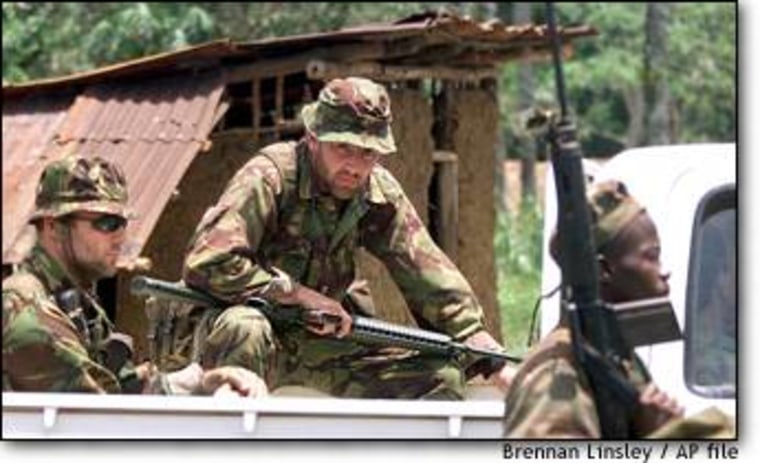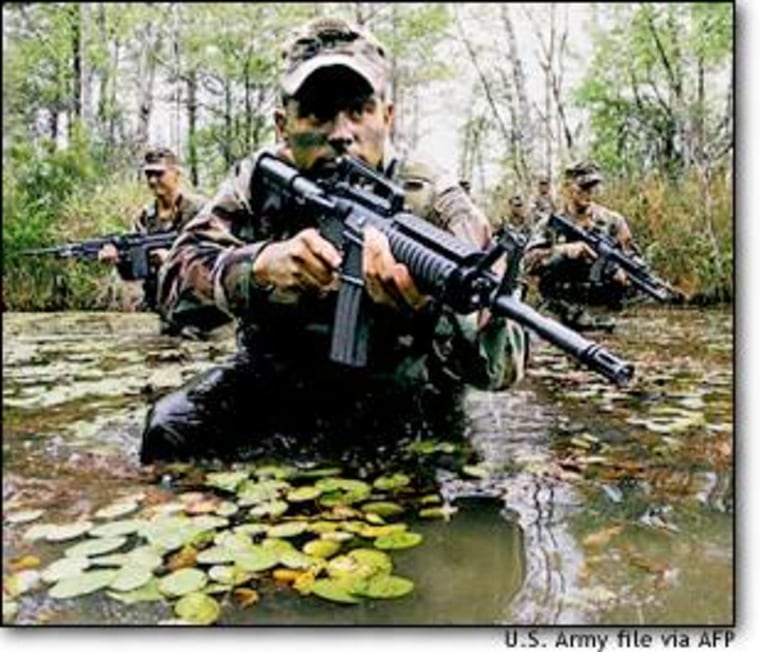The U.S. and British special forces scouting out Afghanistan are veterans of many battles, including stunning victories, bitter defeats and countless secret missions that may never be revealed. These units are now heralded as the sharp end of the spear the United States is pointing at extremist networks around the globe. Yet their unconventional tactics, conflicting national priorities, intra-service turf wars and a few high-profile disasters have hampered them in the political fight for funding.
THE U.S. ARMY Green Berets and Rangers, the Navy’s SEALs and their British counterparts — the Special Air Service (SAS) and the Special Boat Squadron (SBS) — are highly specialized forces generally deployed for deep reconnaissance and sabotage behind enemy lines. Each has its own specialization, and there is considerable rivalry between them for recognition as the creme de la creme.
Together with the larger Marine Expeditionary Units (MEUs) and the Army’s 75th Ranger regiment, plus other units specializing in intelligence and information warfare, the U.S. special operations forces broadly defined number about 50,000 troops. Those units are working closely in this conflict with approximately 25,000 British commandos.
Though varying estimates of the strength of Taliban armed forces suggest that a combined special forces attack would outnumber the fighters of the Afghan regime, it is wrong to evaluate these forces numerically. Unlike other U.S. and British war-fighting divisions — the large armored or infantry divisions, for instance — special forces are trained to fight in small, highly concentrated units that don’t have the luxury of constant communications with their headquarters.
“You’re really dropped in there with a goal, not with orders,” says a former SAS officer who, in keeping with the traditions of the organization, asked to remain anonymous. “Radioing back to base for orders is the surest way of revealing your position when you’re behind lines. We go in with a mission and a series of rendezvous points for extraction. Beyond that, you think for yourself.”
THE MOGADISHU EFFECT
It is precisely this aspect of special forces tactics that has caused some generals and defense planners steeped in the more structured aspects of war to regard them with some suspicion. Some who showed hesitance to use such tactics have cited the failed 1980 Desert One hostage rescue attempt in the Iranian desert and the later, even more devastating ambush of Army Rangers in a raid on a Somali warlord’s compound in Mogadishu in 1993. That raid led to a televised firefight and the deaths of 18 Rangers, hundreds of Somalis and, ultimately, the withdrawal of U.S. forces from the region.
Indeed, following the 1998 bombings of the U.S. embassies in Kenya and Tanzania — attacks also laid at Osama bin Laden’s feet by U.S. intelligence — Army special forces units conducted training missions to “snatch” bin Laden from his Afghan redoubt. Sources with knowledge of these exercises, some of which were conducted inside Uzbekistan as late as mid-2000, say requests to green-light such a mission were turned down by the Joint Chiefs of Staff and the White House on the grounds they were too risky.
“Risky is what these guys do, you know,” one source said. “In retrospect, it seems like a huge miscalculation. But a lot of people looked at what happened in Somalia and didn’t want to see it happen again.”
A similar caution attached itself to the SAS in Britain after its troops let loose on Irish Republican Army members that British intelligence suspected of planning an attack on the country’s base at Gibraltar in 1988. All four who died turned out to be unarmed, and no bomb was found. As with most British intelligence, details of the failed mission are more closely kept than similar secrets in the United States.

But British reports suggest the SAS and other commando units that operated regularly in Northern Ireland and later in the Gulf War and the Balkans have since suffered budget setbacks in training and equipment.
THE STRUCTURAL ISSUE
Beyond the political squeamishness about deploying such forces — particularly in the casualty-averse United States — the dynamics of the gargantuan effort to “remake” the U.S. military after the Cold War has left the special forces with a mixed bag. During the 1990s, Rangers and their famed but secret “Delta Force,” along with SEALs and SAS units, fought behind the lines in the Gulf War, primarily searching Iraq’s western desert for Scud missile sites. In Bosnia and later Kosovo, these units operated behind the lines marking targets for smart weapons, acting as advance scouts for NATO troops and, most famously, rescuing a downed U.S. pilot in the first days of the Kosovo war.
While these exploits brought them new fans inside the military, they continued to lose some of the political battles being fought in Washington over how to wage war in the 21st century. For instance, the $4 billion annual budget for special forces is only 2 percent of overall military spending in the 2001 military budget. Despite reports and presidential panels and the recent “top-down” review of the military’s requirements, money is being poured into new aircraft carriers, two separate new-generation fighter aircraft and an Army self-propelled artillery gun that will be difficult to airlift anywhere.
“Could we build more big-deck carriers and Abrams tanks and still be untouchable? Maybe,” said Andy Krepenevich, a former Pentagon analyst now with the Center for Strategic and Budgetary Assessments in Washington. “But the smart thing to do is take advantage of the huge lead we have and really match our tools with the scary new world out there.” Krepenevich’s assessment came in February.
HEY, THAT’S MY JOB!

More practically, the effort to turn the military machine that faced down the Soviet army into one that can handle everything from a major war to the “war on terrorism” has been marked by inter-service rivalries, as well.
For instance, the Army is well into an effort to develop “interim brigades” that would be armed with a new, light tank capable of fast deployment to places like Afghanistan. This would give the military an option that bridges the gap between the lightly armed special forces and airborne units, and the heavy armored and infantry divisions that take months to put into place. The gap was made painfully clear during the Gulf War, when the U.S. 101st and 82nd Airborne divisions were quickly thrown into place along the Saudi-Kuwaiti border with very little in the way of armor to back them up. No less an authority than Gen. Norman Schwartzkopf, now retired, has said that Iraq could have rolled right through there if its generals had been more aware of these units’ limitations.
The Army’s efforts to deploy so-called interim brigades and a yet-to-be built “light armored vehicle,” however, run afoul of the Marines, who argue that the Army is encroaching on its mission. And, indeed, the Marine Expeditionary Units — two of which are afloat on large amphibious assault ships at all times — were designed for precisely that. The whole concept of the “interim brigade,” in fact, makes some Marines fume.
“There is no missing element in America’s arsenal — it was simply overlooked. For two centuries the Marine Corps has been the only real mobile force in readiness as proven by operations in past conflicts,” said Sgt. Mitchell C. Bloomfield, “Any Marine Corps unit in the world can be deployed in 48 hours after activation. You can’t find a leaner, nimbler, stealthier weapon than that.”
Army Chief of Staff Erik Shinseki, a chief mover behind the transformation of his service, insists that it will still be the Marines’ job to “kick down the door.” But if history is any guide, the service rivalries will complicate, and slow, the effort to remake the military for the 21st century.
